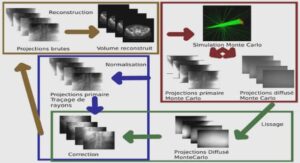Identification et contrôle des systèmes non linéaires
Méthodes d’identification de sous-espaces
L’identification des systèmes dynamiques, notamment l’identification des systèmes à entrées multiples/sorties-multiples, est un domaine de recherche qui ne cesse de prendre de l’importance. Le problème d’identification intervient dans plusieurs domaines de recherche et dans beaucoup d’applications en pratique. Citons, par exemple, la simulation des systèmes chimiques ou biochimiques et l’identification des modes de vibration pour des systèmes flexibles. Les premièrese tentatives pour identifier les systèmes à entrées-multiples/sorties-multiples ont été basées sur l’adaptation des méthodes classiques d’identification tel que les méthodes de prédiction d’erreur et les méthodes des variables instrumentales. Les propriétés statistiques de ces méthodes et leur relation étroite avec l’estimateur de minimum de vraisemblance ont rendu ces méthodes très populaires. En outre, ces méthodes ont été appliquées en pratique pour identifier plusieurs systèmes réels. Cependant, dans le cas des systèmes à entrées-multiples/sorties-multiples, les méthodes classiques présentent divers défauts . Cela est lié au modèle d’équation différentielle utilisé dans les méthodes classiques. Afin de dépasser ces limites, l’utilisation du modèle d’espace d’état a été proposé [Viberg 1995]. Ce type de modèle se révèle particulièrement utile et robuste pour les systèmes complexes. Un modèle linéaire d’espace d’état peut ˆetre défini comme suit xt = Axt−1 +But yt = Cxt +vt o`u xt ∈ R n ,ut ∈ R m,yt ∈ R p et vt ∈ R p sont respectivement l’état interne du système, le signal d’entrée, le signal de sortie et le bruit des mesures. La dimension d’état interne du système n est nommé le degré du système. Dans ces dernières décennies, l’identification de modèles linéaires d’espace d’état est devenu un thème de recherche très active. De nouvelles méthodes sont également apparues; il s’agit des méthodes de sous-espaces. Dans le chapitre 2, nous présenterons plusieurs méthodes de sous-espaces et nous donnerons Résumé du chapitre 2 un bref historique du développement des ces méthodes. Dans le paragraphe suivant, nous présenteront brièvement la méthode PO (Past Output)- MOESP (Multivariable Output-Error State-sPace) [Viberg 1995; Verhaegen 1994]. Cette méthode de sous-espaces sera principalement utilisée dans la suite du manuscrit. Méthode PO-MOESP La méthode consiste à stocker dans un premier temps les entrées et les sorties du système linéaire sous la forme matricielle d’ Hankel: UN 1,α , u1 u2 ··· uN−α+1 u2 u3 ··· uN−α+2 . . . . . . . . . . . . uα uα+1 ··· uN o`u (1,α) représentent respectivement l’indice du premier échantillon et le nombre de lignes de la matrice. N désigne l’indice du dernier échantillon. Le nombre de lignes α doit ˆetre choisi tel qu’il soit supérieur à la dimension du système n [Viberg 1995; Verhaegen 1994]. Les matrices de sortie YN 1,α et de bruit VN 1,α sont définies du mˆeme manière. L’équation entrée/sortie suivante est alors facilement déduite de la description du système: YN 1,α = ΓαX1,N−α+1 + ΦαUN 1,α +VN 1,α o`u Γ 1 α est la matrice étendue d’observabilité du système. Φα est une matrice triangulaire par blocs. Celles-ci sont définies par : Γα = C CA . . . CA(α−1) Φ1 α = 0 0 0 ··· 0 CB 0 0 ··· 0 CAB CB 0 ··· 0 . . . . . . . . . . . . . . . CA(α−2)B ··· ··· CB 0 X1,N−α+1 = h x1 x2 ···xN−α+1i . Le principe de cette méthode est d’utiliser les mesures passées comme variables instrumentales, ceci afin de minimiser les effets du bruit.
Subspace Identification Methods
The problem of identifying Multi-Input Multi-Output (MIMO) systems is one of the most active subject in dynamic systems identification. This problem arises in a variety of applications, ranging from chemical process simulations and control to identifications of vibrational modes in flexible structures. The necessity of developing methods to deal with the identification of MIMO systems was a real challenge for the researchers. The first attempt was to adapt the traditional system identification techniques, which are the prediction error method (PEM) and the instrumental variable method (IVM). These methods has been applied to identify many real-world problems and found to perform well thanks to their well known statistical properties and their relations to maximum-likelihood estimation. However, in the case of MIMO systems, they have some shortcoming. This is because the candidate model structure of PEM and IVM methods is primarily linear difference equation. This model relates the outputs to the inputs signals by the following formula X Ny i=0 αiyt−i = X Nu j=0 βjut−j + X Ne k=0 γket−k (2.1) where yt is the output signal, ut is the input signal and et is the measurement noise which is supposed to be white noise and independent of the input signals. This model is really interesting in the case of Single Input-Single Output (SISO) systems where the coefficients {αi ,βj , γk : i = 0,1,2,··· ,Ny; j = 0,1,2,··· ,Nu;k = 0,1,2,··· ,Ne} are scalar. 15 16 Chapter 2. Subspace Identification Methods On the other hand, using such models is quite cumbersome in the general case of MIMO systems, and the numerical reliability may be poor for large system order. This is obvious on account of the effect that the coefficients, in this case, become matrices and without any assumption on the structure of these matrices, they are full parameterized. To overcome the limitations of difference equation model, the use of state-space model is preferred typically for complex problems [Viberg 1995]. The remainder of this chapter is organized as follows. Section 2.1 gives an overview of state space realization and the notions of controllability, observability and similarity are introduced. The origin and various classes of subspace methods are given in Section 2.2.
State Space Realization
The state-space realization of a linear time-invariant (LTI) system, in the absence of noise, is the following xt =Axt−1 +But yt =Cxt (2.2) where xt is the internal state of the system and its dimension is equal to n (the system order), yt ∈ R p is the output signal , ut ∈ R m is the input signal. The matrices {A,B,C} are constant matrices. The direct relation between the input and the output of the system is given by the following formula yt = X∞ k=0 hkut−k (2.3) where hk = CAkB (2.4) hk denotes the p×m matrix of impulse responses or the Markov parameters. 2.1.1 Controllability, Observability and Minimality A state-space realization is observable if and only if Rank(Γn) = n (2.5) where Γn = C CA . . . CAn−1 (2.6) and Rank stands for the number of independent rows or columns in a matrix. A state-space realization is controllable if and only if Rank(Ωn) = n (2.7) where Ωn = h B AB ··· An−1B i (2.8) We call a state-space realization minimal if there exists no other realization of lower degree. As a consequence, the minimal realization are always both observable and controllable. 2.1.2 Stability The system represented in state space realization is stable if and only if ρ(A) < 1 (2.9) where ρ(A) designs the spectrum radius of the matrix A defined as follows ρ(A) = max i=1,2,···,n |λi | : λi is an eigenvalue of matrix A (2.10)
Similarity and Canonical Forms
Let T ∈ R n×n be a nonsingular matrix. If the internal state xt is transformed as follows zt = (T) −1 xt (2.11) It is then easy to see that zt =Az¯ t−1 +Bu¯ t yt =Cz¯ t (2.12) where » A¯ B¯ C¯ 0 # = » (T) −1 AT (T) −1 B CT 0 # (2.13) It is clear that the transformation (2.11) provides an alternative state-space realization. This is because the input/output relation is still invariant, and of course the transfer function also. As 17 18 Chapter 2. Subspace Identification Methods can easily be checked H (z) = C (zI −A) −1 B = C¯ zI −A¯ −1 B¯ (2.14) In point of fact, the state-space realization can be made unique by choosing an appropriate parameterization. For LTI systems, various canonical forms have been proposed such as 1. Observable canonical form: In this from the matrix A has the following structure A = −α1 1 0 ··· 0 −α2 0 1 ··· 0 . . . . . . . . . . . . . . . −αn−1 0 ··· ··· 1 −αn 0 0 ··· 0 (2.15) and the matrices B and C are full parameterized. SISO system case: In this case, the matrices B and C have the following forms B T = h b1 b2 ··· bn i C = h 1 0 ··· 0 i (2.16) 2. Controllable form: In this from the matrix A has the following structure A = 0 1 0 ··· 0 0 0 1 ··· 0 . . . . . . . . . . . . . . . 0 0 ··· ··· 1 −α1 −α2 −α3 ··· −αn (2.17) and the matrices B and C are full parameterized. SISO system case: In this case, the matrices B and C have the following forms B T = h 0 ··· 0 1i C = h c1 c2 ··· cn i (2.18) Note that, the popular form in system identification is the observable form. This is because the system is supposed to be observable by definition.
1 Introduction |





